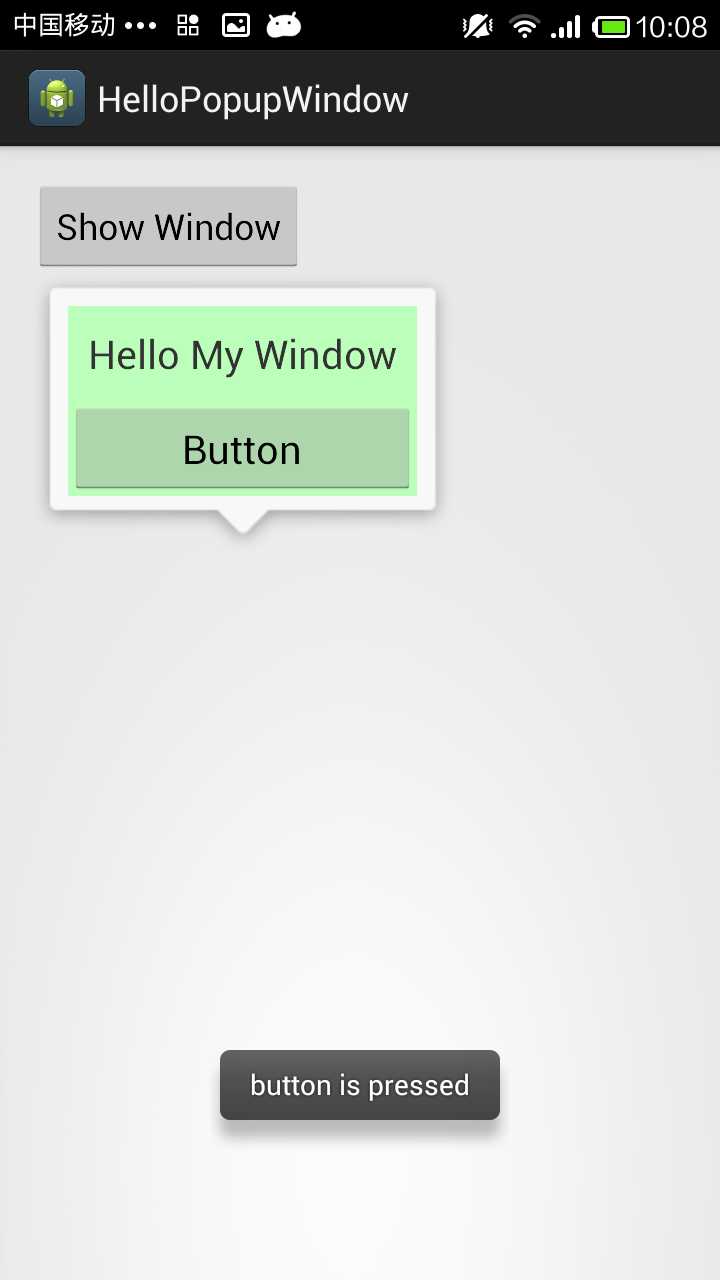标签:
原文:http://www.cnblogs.com/mengdd/p/3569127.html
PopupWindow这个类用来实现一个弹出框,可以使用任意布局的View作为其内容,这个弹出框是悬浮在当前activity之上的。
这个类的使用,不再过多解释,直接上代码吧。
比如弹出框的布局:

<?xml version="1.0" encoding="utf-8"?> <LinearLayout xmlns:android="http://schemas.android.com/apk/res/android" android:layout_width="match_parent" android:layout_height="wrap_content" android:background="#FFBBFFBB" android:orientation="vertical" > <TextView android:layout_width="match_parent" android:layout_height="wrap_content" android:padding="10dp" android:text="Hello My Window" android:textSize="20sp" /> <Button android:id="@+id/button1" android:layout_width="match_parent" android:layout_height="wrap_content" android:padding="10dp" android:text="Button" android:textSize="20sp" /> </LinearLayout>
Activity的布局中只有一个按钮,按下后会弹出框,Activity代码如下:
package com.example.hellopopupwindow; import android.os.Bundle; import android.app.Activity; import android.content.Context; import android.util.Log; import android.view.LayoutInflater; import android.view.MotionEvent; import android.view.View; import android.view.View.OnClickListener; import android.view.View.OnTouchListener; import android.view.ViewGroup.LayoutParams; import android.widget.Button; import android.widget.PopupWindow; import android.widget.Toast; public class MainActivity extends Activity { private Context mContext = null; @Override protected void onCreate(Bundle savedInstanceState) { super.onCreate(savedInstanceState); setContentView(R.layout.activity_main); mContext = this; Button button = (Button) findViewById(R.id.button); button.setOnClickListener(new View.OnClickListener() { @Override public void onClick(View view) { showPopupWindow(view); } }); } private void showPopupWindow(View view) { // 一个自定义的布局,作为显示的内容 View contentView = LayoutInflater.from(mContext).inflate( R.layout.pop_window, null); // 设置按钮的点击事件 Button button = (Button) contentView.findViewById(R.id.button1); button.setOnClickListener(new OnClickListener() { @Override public void onClick(View v) { Toast.makeText(mContext, "button is pressed", Toast.LENGTH_SHORT).show(); } }); final PopupWindow popupWindow = new PopupWindow(contentView, LayoutParams.WRAP_CONTENT, LayoutParams.WRAP_CONTENT, true); popupWindow.setTouchable(true); popupWindow.setTouchInterceptor(new OnTouchListener() { @Override public boolean onTouch(View v, MotionEvent event) { Log.i("mengdd", "onTouch : "); return false; // 这里如果返回true的话,touch事件将被拦截 // 拦截后 PopupWindow的onTouchEvent不被调用,这样点击外部区域无法dismiss } }); // 如果不设置PopupWindow的背景,无论是点击外部区域还是Back键都无法dismiss弹框 // 我觉得这里是API的一个bug popupWindow.setBackgroundDrawable(getResources().getDrawable( R.drawable.selectmenu_bg_downward)); // 设置好参数之后再show popupWindow.showAsDropDown(view); } }
弹出框的布局中有一个TextView和一个Button,Button点击后显示Toast,如图:

第一次实现的时候遇到了问题,就是弹出框不会在按下Back键的时候消失,点击弹框外区域也没有正常消失,搜索了一下,都说只要设置背景就好了。
然后我就找了个图片,果然弹框能正常dismiss了(见注释)。
为了解答一下上面的问题,看看源码(最新API Level 19,Android 4.4.2)。
1.显示方法
显示提供了两种形式:
showAtLocation()显示在指定位置,有两个方法重载:
public void showAtLocation(View parent, int gravity, int x, int y) public void showAtLocation(IBinder token, int gravity, int x, int y)
showAsDropDown()显示在一个参照物View的周围,有三个方法重载:
public void showAsDropDown(View anchor) public void showAsDropDown(View anchor, int xoff, int yoff) public void showAsDropDown(View anchor, int xoff, int yoff, int gravity)
最后一种带Gravity参数的方法是API 19新引入的。
弹出的方法中首先需要preparePopup(),最后再invokePopup()。
prepare的方法中可以看到有无背景的分别:
/** * <p>Prepare the popup by embedding in into a new ViewGroup if the * background drawable is not null. If embedding is required, the layout * parameters‘ height is mnodified to take into account the background‘s * padding.</p> * * @param p the layout parameters of the popup‘s content view */ private void preparePopup(WindowManager.LayoutParams p) { if (mContentView == null || mContext == null || mWindowManager == null) { throw new IllegalStateException("You must specify a valid content view by " + "calling setContentView() before attempting to show the popup."); } if (mBackground != null) { final ViewGroup.LayoutParams layoutParams = mContentView.getLayoutParams(); int height = ViewGroup.LayoutParams.MATCH_PARENT; if (layoutParams != null && layoutParams.height == ViewGroup.LayoutParams.WRAP_CONTENT) { height = ViewGroup.LayoutParams.WRAP_CONTENT; } // when a background is available, we embed the content view // within another view that owns the background drawable PopupViewContainer popupViewContainer = new PopupViewContainer(mContext); PopupViewContainer.LayoutParams listParams = new PopupViewContainer.LayoutParams( ViewGroup.LayoutParams.MATCH_PARENT, height ); popupViewContainer.setBackgroundDrawable(mBackground); popupViewContainer.addView(mContentView, listParams); mPopupView = popupViewContainer; } else { mPopupView = mContentView; } mPopupViewInitialLayoutDirectionInherited = (mPopupView.getRawLayoutDirection() == View.LAYOUT_DIRECTION_INHERIT); mPopupWidth = p.width; mPopupHeight = p.height; }
2.背景是否为空对Touch事件的影响
如果有背景,则会在contentView外面包一层PopupViewContainer之后作为mPopupView,如果没有背景,则直接用contentView作为mPopupView。
而这个PopupViewContainer是一个内部私有类,它继承了FrameLayout,在其中重写了Key和Touch事件的分发处理:
@Override public boolean dispatchKeyEvent(KeyEvent event) { if (event.getKeyCode() == KeyEvent.KEYCODE_BACK) { if (getKeyDispatcherState() == null) { return super.dispatchKeyEvent(event); } if (event.getAction() == KeyEvent.ACTION_DOWN && event.getRepeatCount() == 0) { KeyEvent.DispatcherState state = getKeyDispatcherState(); if (state != null) { state.startTracking(event, this); } return true; } else if (event.getAction() == KeyEvent.ACTION_UP) { KeyEvent.DispatcherState state = getKeyDispatcherState(); if (state != null && state.isTracking(event) && !event.isCanceled()) { dismiss(); return true; } } return super.dispatchKeyEvent(event); } else { return super.dispatchKeyEvent(event); } } @Override public boolean dispatchTouchEvent(MotionEvent ev) { if (mTouchInterceptor != null && mTouchInterceptor.onTouch(this, ev)) { return true; } return super.dispatchTouchEvent(ev); } @Override public boolean onTouchEvent(MotionEvent event) { final int x = (int) event.getX(); final int y = (int) event.getY(); if ((event.getAction() == MotionEvent.ACTION_DOWN) && ((x < 0) || (x >= getWidth()) || (y < 0) || (y >= getHeight()))) { dismiss(); return true; } else if (event.getAction() == MotionEvent.ACTION_OUTSIDE) { dismiss(); return true; } else { return super.onTouchEvent(event); } }
由于PopupView本身并没有重写Key和Touch事件的处理,所以如果没有包这个外层容器类,点击Back键或者外部区域是不会导致弹框消失的。
补充Case: 弹窗不消失,但是事件向下传递
如上所述:
设置了PopupWindow的background,点击Back键或者点击弹窗的外部区域,弹窗就会dismiss.
相反,如果不设置PopupWindow的background,那么点击back键和点击弹窗的外部区域,弹窗是不会消失的.
那么,如果我想要一个效果,点击外部区域,弹窗不消失,但是点击事件会向下面的activity传递,比如下面是一个WebView,我想点击里面的链接等.
/** * Set whether this window is touch modal or if outside touches will be sent * to * other windows behind it. * */ public static void setPopupWindowTouchModal(PopupWindow popupWindow, boolean touchModal) { if (null == popupWindow) { return; } Method method; try { method = PopupWindow.class.getDeclaredMethod("setTouchModal", boolean.class); method.setAccessible(true); method.invoke(popupWindow, touchModal); } catch (Exception e) { e.printStackTrace(); } }
然后在程序中:
UIUtils.setPopupWindowTouchModal(popupWindow, false);标签:
原文地址:http://www.cnblogs.com/gofan/p/5687218.html